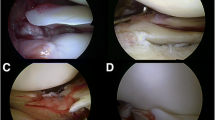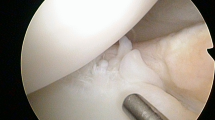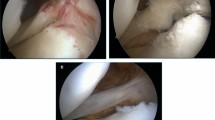Abstract
Purpose
The purpose of this study was (1) to describe the meniscus tear pattern in anterior cruciate ligament (ACL)-injured patients, with a special focus on medial meniscus (MM) ramp lesions and lateral meniscus (LM) root tears and (2) to determine whether patient and injury characteristics were associated with meniscus tear patterns.
Methods
Data from 358 cases of ACL primary and revision reconstruction surgeries were extracted from a center-based registry. During arthroscopy, the presence of associated meniscus lesions was documented by systematically inspecting the anterior and posterior tibiofemoral compartments. With a special focus on MM ramp lesions and LM root tears, groups of different injury tear patterns were formed. Chi-square tests were used to determine whether these groups differed with respect to various patient and injury characteristics, including gender, previous ipsilateral ACL injuries, the injury’s relation to sport, person contact during injury and the type of ACL tear. Median age at surgery and body mass index were compared between groups using the Kruskal–Wallis test. Significance was set at p < 0.05.
Results
Two hundred and thirty-nine ACL injuries (67%) showed additional meniscal injuries, of which 125 (52%) involved the MM ramp and/or the LM root. Ramp lesions were more frequent in males (23% vs 12% in females, p < 0.01), in contact injuries (28% vs 16% in non-contact, p < 0.05) and in complete ACL tears (21% vs 5% in partial, p < 0.05). Combined injuries of the MM ramp and the LM root showed a higher percentage of contact injuries compared to non-contact injuries (10% vs 4%, p < 0.05).
Conclusion
Two-thirds of all ACL injuries showed a concomitant meniscus injury, of which half involved the biomechanically relevant, but previously often undiagnosed RLMM or the PRLM. These findings provide evidence that until recently about half of ACL-associated meniscus injuries were not properly identified. Ramp lesions were more frequent in males, contact injuries and in complete ACL tears. These findings stress the need for a systematic assessment and a better understanding of the pathomechanism of these specific injuries which may have an important impact on knee biomechanics and the outcome of ACL reconstruction.
Level of evidence
III.

Similar content being viewed by others
References
Ahn JH, Bae TS, Kang KS, Kang SY, Lee SH (2011) Longitudinal tear of the medial meniscus posterior horn in the anterior cruciate ligament-deficient knee significantly influences anterior stability. Am J Sports Med 39:2187–2193
Ahn JH, Lee YS, Yoo JC, Chang MJ, Park SJ, Pae YR (2010) Results of arthroscopic all-inside repair for lateral meniscus root tear in patients undergoing concomitant anterior cruciate ligament reconstruction. Arthroscopy 26:67–75
Ahn JH, Oh I (2006) Arthroscopic all-inside lateral meniscus suture using posterolateral portal. Arthroscopy 22(572):e571-574
Anderson AF, Irrgang JJ, Dunn W, Beaufils P, Cohen M, Cole BJ et al (2011) Interobserver reliability of the International Society of Arthroscopy, Knee Surgery and Orthopaedic Sports Medicine (ISAKOS) classification of meniscal tears. Am J Sports Med 39:926–932
Balazs GC, Greditzer HG, Wang D, Marom N, Potter HG, Marx RG et al (2019) Ramp lesions of the medial meniscus in patients undergoing primary and revision ACL reconstruction: prevalence and risk factors. Orthop J Sports Med 7:2325967119843509
Balazs GC, Greditzer HG, Wang D, Marom N, Potter HG, Rodeo SA et al (2020) Non-treatment of stable ramp lesions does not degrade clinical outcomes in the setting of primary ACL reconstruction. Knee Surg Sports Traumatol Arthrosc. https://doi.org/10.1007/s00167-020-06017-1
Brambilla L, Pulici L, Carimati G, Quaglia A, Prospero E, Bait C et al (2015) Prevalence of associated lesions in anterior cruciate ligament reconstruction: correlation with surgical timing and with patient age, sex, and body mass index. Am J Sports Med 43:2966–2973
Bumberger A, Koller U, Hofbauer M, Tiefenboeck TM, Hajdu S, Windhager R et al (2020) Ramp lesions are frequently missed in ACL-deficient knees and should be repaired in case of instability. Knee Surg Sports Traumatol Arthrosc 28:840–854
Church S, Keating JF (2005) Reconstruction of the anterior cruciate ligament: timing of surgery and the incidence of meniscal tears and degenerative change. J Bone Jt Surg Br 87:1639–1642
Colombet P, Dejour D, Panisset JC, Siebold R, French Arthroscopy S (2010) Current concept of partial anterior cruciate ligament ruptures. Orthop Traumatol Surg Res 96:S109–S118
DeFranco MJ, Bach BR Jr (2009) A comprehensive review of partial anterior cruciate ligament tears. J Bone Jt Surg Am 91:198–208
Dejour D, Ntagiopoulos PG, Saggin PR, Panisset JC (2013) The diagnostic value of clinical tests, magnetic resonance imaging, and instrumented laxity in the differentiation of complete versus partial anterior cruciate ligament tears. Arthroscopy 29:491–499
DePhillipo NN, Moatshe G, Brady A, Chahla J, Aman ZS, Dornan GJ et al (2018) Effect of meniscocapsular and meniscotibial lesions in ACL-deficient and ACL-reconstructed knees: a biomechanical study. Am J Sports Med 46:2422–2431
Feucht MJ, Bigdon S, Mehl J, Bode G, Muller-Lantzsch C, Sudkamp NP et al (2015) Risk factors for posterior lateral meniscus root tears in anterior cruciate ligament injuries. Knee Surg Sports Traumatol Arthrosc 23:140–145
Feucht MJ, Salzmann GM, Bode G, Pestka JM, Kuhle J, Sudkamp NP et al (2015) Posterior root tears of the lateral meniscus. Knee Surg Sports Traumatol Arthrosc 23:119–125
Forkel P, Reuter S, Sprenker F, Achtnich A, Herbst E, Imhoff A et al (2015) Different patterns of lateral meniscus root tears in ACL injuries: application of a differentiated classification system. Knee Surg Sports Traumatol Arthrosc 23:112–118
Forkel P, von Deimling C, Lacheta L, Imhoff FB, Foehr P, Willinger L et al (2018) Repair of the lateral posterior meniscal root improves stability in an ACL-deficient knee. Knee Surg Sports Traumatol Arthrosc 26:2302–2309
Frank JM, Moatshe G, Brady AW, Dornan GJ, Coggins A, Muckenhirn KJ et al (2017) Lateral meniscus posterior root and meniscofemoral ligaments as stabilizing structures in the ACL-deficient knee: a biomechanical study. Orthop J Sports Med 5:2325967117695756
Gillquist J, Hagberg G, Oretorp N (1979) Arthroscopic examination of the posteromedial compartment of the knee joint. Int Orthop 3:13–18
Granan LP, Inacio MC, Maletis GB, Funahashi TT, Engebretsen L (2013) Sport-specific injury pattern recorded during anterior cruciate ligament reconstruction. Am J Sports Med 41:2814–2818
Greif DN, Baraga MG, Rizzo MG, Mohile NV, Silva FD, Fox T et al (2020) MRI appearance of the different meniscal ramp lesion types, with clinical and arthroscopic correlation. Skelet Radiol 49:677–689
Grindem H, Eitzen I, Engebretsen L, Snyder-Mackler L, Risberg MA (2014) Nonsurgical or surgical treatment of ACL injuries: knee function, sports participation, and knee reinjury: the Delaware-Oslo ACL Cohort Study. J Bone Jt Surg Am 96:1233–1241
Hamberg P, Gillquist J, Lysholm J (1983) Suture of new and old peripheral meniscus tears. J Bone Jt Surg Am 65:193–197
Kocher MS, Steadman JR, Briggs K, Zurakowski D, Sterett WI, Hawkins RJ (2002) Determinants of patient satisfaction with outcome after anterior cruciate ligament reconstruction. J Bone Jt Surg Am 84:1560–1572
Kocher MS, Steadman JR, Briggs KK, Sterett WI, Hawkins RJ (2004) Relationships between objective assessment of ligament stability and subjective assessment of symptoms and function after anterior cruciate ligament reconstruction. Am J Sports Med 32:629–634
Krych AJ, Wu IT, Desai VS, Murthy NS, Collins MS, Saris DBF et al (2018) High rate of missed lateral meniscus posterior root tears on preoperative magnetic resonance imaging. Orthop J Sports Med 6:2325967118765722
Liu X, Feng H, Zhang H, Hong L, Wang XS, Zhang J (2011) Arthroscopic prevalence of ramp lesion in 868 patients with anterior cruciate ligament injury. Am J Sports Med 39:832–837
Lording T, Corbo G, Bryant D, Burkhart TA, Getgood A (2017) Rotational laxity control by the anterolateral ligament and the lateral meniscus is dependent on knee flexion angle: a cadaveric biomechanical study. Clin Orthop Relat Res 475:2401–2408
Magnussen RA, Spindler KP (2011) The effect of patient and injury factors on long-term outcome after anterior cruciate ligament reconstruction. Curr Orthop Pract 22:90–103
Minami T, Muneta T, Sekiya I, Watanabe T, Mochizuki T, Horie M et al (2018) Lateral meniscus posterior root tear contributes to anterolateral rotational instability and meniscus extrusion in anterior cruciate ligament-injured patients. Knee Surg Sports Traumatol Arthrosc 26:1174–1181
Mouton C, Magosch A, Pape D, Hoffmann A, Nuhrenborger C, Seil R (2020) Ramp lesions of the medial meniscus are associated with a higher grade of dynamic rotatory laxity in ACL-injured patients in comparison to patients with an isolated injury. Knee Surg Sports Traumatol Arthrosc 28:1023–1028
Musahl V, Rahnemai-Azar AA, Costello J, Arner JW, Fu FH, Hoshino Y et al (2016) The influence of meniscal and anterolateral capsular injury on knee laxity in patients with anterior cruciate ligament injuries. Am J Sports Med 44:3126–3131
Peltier A, Lording T, Maubisson L, Ballis R, Neyret P, Lustig S (2015) The role of the meniscotibial ligament in posteromedial rotational knee stability. Knee Surg Sports Traumatol Arthrosc 23:2967–2973
Praz C, Vieira TD, Saithna A, Rosentiel N, Kandhari V, Nogueira H et al (2019) Risk factors for lateral meniscus posterior root tears in the anterior cruciate ligament-injured knee: an epidemiological analysis of 3956 patients from the SANTI Study Group. Am J Sports Med 47:598–605
Prentice HA, Lind M, Mouton C, Persson A, Magnusson H, Gabr A et al (2018) Patient demographic and surgical characteristics in anterior cruciate ligament reconstruction: a description of registries from six countries. Br J Sports Med 52:716–722
Ristanis S, Stergiou N, Patras K, Vasiliadis HS, Giakas G, Georgoulis AD (2005) Excessive tibial rotation during high-demand activities is not restored by anterior cruciate ligament reconstruction. Arthroscopy 21:1323–1329
Seil R, Hoffmann A, Scheffler S, Theisen D, Mouton C, Pape D (2017) Ramp lesions: tips and tricks in diagnostics and therapy. Orthopade 46:846–854
Seil R, Mouton C, Coquay J, Hoffmann A, Nuhrenborger C, Pape D et al (2018) Ramp lesions associated with ACL injuries are more likely to be present in contact injuries and complete ACL tears. Knee Surg Sports Traumatol Arthrosc 26:1080–1085
Shybut TB, Vega CE, Haddad J, Alexander JW, Gold JE, Noble PC et al (2015) Effect of lateral meniscal root tear on the stability of the anterior cruciate ligament-deficient knee. Am J Sports Med 43:905–911
Song GY, Liu X, Zhang H, Wang QQ, Zhang J, Li Y et al (2016) Increased medial meniscal slope is associated with greater risk of ramp lesion in noncontact anterior cruciate ligament injury. Am J Sports Med 44:2039–2046
Sonnery-Cottet B, Conteduca J, Thaunat M, Gunepin FX, Seil R (2014) Hidden lesions of the posterior horn of the medial meniscus: a systematic arthroscopic exploration of the concealed portion of the knee. Am J Sports Med 42:921–926
Sonnery-Cottet B, Praz C, Rosenstiel N, Blakeney WG, Ouanezar H, Kandhari V et al (2018) Epidemiological evaluation of meniscal ramp lesions in 3214 anterior cruciate ligament-injured knees from the SANTI Study Group Database: a risk factor analysis and study of secondary meniscectomy rates following 769 ramp repairs. Am J Sports Med 46:3189–3197
Stephen JM, Kittl C, Williams A, Zaffagnini S, Marcheggiani Muccioli GM, Fink C et al (2016) Effect of medial patellofemoral ligament reconstruction method on patellofemoral contact pressures and kinematics. Am J Sports Med 44:1186–1194
Tashman S, Collon D, Anderson K, Kolowich P, Anderst W (2004) Abnormal rotational knee motion during running after anterior cruciate ligament reconstruction. Am J Sports Med 32:975–983
Thaunat M, Fayard JM, Guimaraes TM, Jan N, Murphy CG, Sonnery-Cottet B (2016) Classification and surgical repair of ramp lesions of the medial meniscus. Arthrosc Tech 5:e871–e875
Thompson WO, Thaete FL, Fu FH, Dye SF (1991) Tibial meniscal dynamics using three-dimensional reconstruction of magnetic resonance images. Am J Sports Med 19:210–215 ((discussion 215–216))
Tomczak M, Tomczak E (2014) The need to report effect size estimates revisited. An overview of some recommended measures of effect size. Trends Sports Sci 21:19–25
Vedi V, Williams A, Tennant SJ, Spouse E, Hunt DM, Gedroyc WM (1999) Meniscal movement. An in-vivo study using dynamic MRI. J Bone Jt Surg Br 81:37–41
Acknowledgements
Project honored with the GOTS Young Investigator Award by Bauerfeind.
Funding
None.
Author information
Authors and Affiliations
Contributions
All authors contributed equally to the study.
Corresponding author
Ethics declarations
Conflict of interest
The authors declare that they have no conflict of interest.
Ethical approval
Ethical approval was provided by National Ethics Committee for Research (No. 201101/05).
Informed consent
All patients signed an informed consent to participate in the study.
Additional information
Publisher's Note
Springer Nature remains neutral with regard to jurisdictional claims in published maps and institutional affiliations.
Rights and permissions
About this article
Cite this article
Magosch, A., Mouton, C., Nührenbörger, C. et al. Medial meniscus ramp and lateral meniscus posterior root lesions are present in more than a third of primary and revision ACL reconstructions. Knee Surg Sports Traumatol Arthrosc 29, 3059–3067 (2021). https://doi.org/10.1007/s00167-020-06352-3
Received:
Accepted:
Published:
Issue Date:
DOI: https://doi.org/10.1007/s00167-020-06352-3




